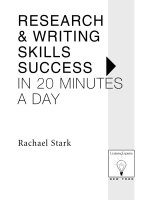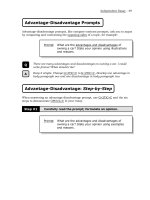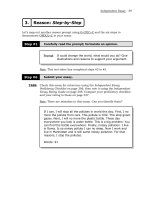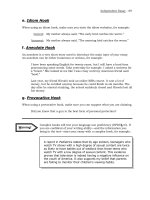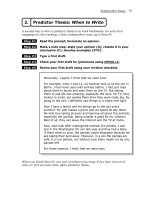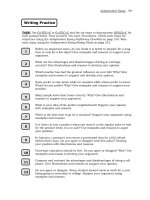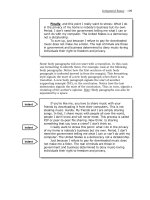Tài liệu RESEARCH AND WRITING SKILLS SUCCESS PART 16 doc
Bạn đang xem bản rút gọn của tài liệu. Xem và tải ngay bản đầy đủ của tài liệu tại đây (78.28 KB, 7 trang )
– ADDING FOOTNOTES, ENDNOTES, AND PARENTHETICAL CITATIONS–
92
You should also use this format if you are
citing a source that you have already used, and
the citations are not consecutive. The word
“Ibid” should only be used when you are refer-
ring to the same source twice in a row.
Citing Electronic Sources
In this age of readily available computer infor-
mation, it is very likely that you have done a
great deal of your research on your computer.
Since this phenomenon is relatively new in
terms of style procedures and precedents, you
might be wondering how to cite electronic
material. Electronic information usually falls
into several broad categories:
1. articles posted and written for the Web
by specific authors
2. online journals and magazines
3. material gathered from general and spe-
cific databases and search engines
4. informal or anonymous listings posted
on the Internet in chat rooms or bulletin
boards.
To cite an electronic document when
there is no author provided, simply begin with
the title. If there is more than one such docu-
ment, alphabetize each piece according to its
title. Similarly, if you have consulted a specific
website or several websites, list them alphabet-
ically, but be sure to include their precise and
complete addresses. When writing your bibli-
ography and/or footnotes, use the following
format:
1. the author’s name (followed by a
period)
2. the name of the article in quotation
marks, followed by a period
3. the name of the web site (underline the
site name—followed by a period)
4. the date of its posting
5. the official web address (be sure to
include all backslashes, brackets etc.)
Example A:
1
Sue Miller. “Kennedy’s Top
Advisors.” Go
vernment Issues. March 20,
2000. www
.go
vernmentissues.com
Similarly, to cite an article from an online
journal or magazine, simply provide:
1. the author of the article (first name fol-
lowed by last name)
2. the title of the article in quotation marks
3. the title of the journal (underline the
title)
4. the volume or issue number
5. the specific page or paragraph number
6. the date of posting and electronic publi-
cation
7. the electronic address
The format is identical to the example
that is listed above and luckily, many online
publications provide paragraph numbers as
well as page numbers, so be sure to include
them whenever available. Remember the more
specific that you can be, the better. Finally, if
you are citing an online posting that comes
from an informal source such as a chat room
or bulletin board, simply write the name of the
person to whom you can attribute a statement,
list the name of the site, and include the date.
A citation would look like this:
Example B:
2
Tim Arnold. “My Thoughts on
Kennedy.” K
ennedy Communicatio
ns Bulletin
Board. January 2, 2001.
Lastly, if you consulted an article from a
reference database on CD-ROM, simply:
1. state the article name (use quotation
marks followed by a period)
2. state the name of the journal (underline
the name-followed by a period)
3. list the format: CD-ROM (followed by a
period)
4. list the place of origin (followed by a
colon)
5. list the software company (followed by a
comma)
6. list the date the software was manufac-
tured or licensed (followed by a period)
In other words, a CD-ROM listing would
look like this:
EXAMPLE C:
3
“Kennedy’s Years In The
White House.” Go
vernment Perspectives.
Seattle: Microsoft, 2000.
Later, if you have consulted different
material from several CD-ROM’s, simply list
the CD-ROM’s in alphabetical order for your
bibliography.
Summary
As you first learn the proper format for cita-
tions, it may seem complex and hard to follow.
It is really not difficult if you take your time
and if you have a thorough guide or an exam-
ple on hand to use as a model. Once you write
a few citations, the process becomes simpler—
almost second nature. When selecting a guide
or style manual, remember to check with your
instructor first to find out what type of guide
he or she prefers, as well as what kind of doc-
umentation procedure is required. What is
more important, however, is that you under-
stand what types of statements need citations
and why you must provide them. Again, while
citing your sources may seem unnecessary and
tedious, it is an important process that pro-
tects you from any charges of plagiarism. In
addition, it gives credibility to your work and
analysis and demonstrates to your reader the
careful and meticulous job that you have done!
– ADDING FOOTNOTES, ENDNOTES, AND PARENTHETICAL CITATIONS–
93
95
A
bibliography should be a complete list of every single item that you have consulted while
you were researching and writing your paper. This list includes all printed matter and any
other sources from which you derived your information. A standard bibliography documents all
printed matter you have read or consulted and includes all reference books, books by a particu-
lar author, articles, pamphlets, or leaflets. Even if you only read several pages or paragraphs from
a large encyclopedia or textbook, it is important to include that book in your bibliography. The
reason that you provide a bibliography for your reader is not only to confirm your own legitima-
cy as a researcher and writer (in other words, that you gathered material and did not “create” it
all in your head), but more importantly, to provide a source for other people interested in your
topic. In a way, you can think of a bibliography as a form of sharing knowledge.
A bibliography should function as a mini library of sorts. Any reader should be able to con-
sult your bibliography (even if he or she has not read your paper) and begin to gather important
titles on a similar topic based on works that you mention. Because bibliographies become official
documents of knowledge in themselves, it is important that they list sources correctly and are
written in proper format. There is nothing worse than referring a reader to a book that does not
Writing a
Bibliography
LESSON SUMMARY
Writing a bibliography is more straightforward than deciding when
and where to use footnotes or citations. In fact, the bibliography
format is very similar to the format for footnotes, with only slight
variations. This lesson will explain why bibliographies are impor-
tant, how to write one, and will provide you with several examples.
19
exist or neglecting to mention a particular
printing or edition of a book that you have
consulted. Listing the book correctly ensures
that the reader doesn’t have to sort through the
previous ten editions hoping to find similar
information.
Standard Bibliographic
Format
A bibliography should come at the very end of
your paper. All books and printed material
should be listed by author’s last name in alpha-
betical order. The author’s name should be
written with the last name first, followed by
the first name. A period comes after the
author’s name. The title is then listed and
either underlined or set off in italics (in the
case of articles, the title is always set off by
quotation marks). The title of the book is fol-
lowed by a period. The next information is the
city where the book is published, followed by a
colon. Then the publishing company is listed,
followed by a comma, and finally the year of
publication, followed by a period. A simple
bibliographic citation might look like this:
Example:
Miller, Sue. The Last Days of President
Kennedy’s Presidency: A Critical Exam-
ination of his Final Economic Policies.
Chicago: University of Chicago Press,
1997.
Unlike a footnote citation, you do not
have to number your sources, there are no
parentheses, and the author’s last name is list-
ed first. Also, the second and succeeding lines
of each entry are always indented five spaces.
Remember to list your sources alphabetically
by the author’s last name.
Bibliographies for
Electronic Sources
Again, this same format holds true for elec-
tronic sources. When listing an author or edi-
tor of an online article simply alphabetize his
or her name (last name first, etc.). Use the
same procedure for multiple authors or edi-
tors. After you have done this, list the title of
the article you consulted (in quotation marks),
the journal in which it was published (under-
line the title), and instead of the publishing
company, list the website and the year the site
was posted. In other words, your bibliograph-
ic citation should look like this:
Example:
Miller, Sue. “Kennedy’s Top Advisors.”
Go
vernment Issues. www.
governmentissues.com. March 20, 2000.
Common Questions
While this format may seem relatively easy,
you might have some questions. For instance,
what if several authors have written a book
together—whose name do you list first? What
if you have read more than one book by the
same author—which title do you list first and
how do you arrange them? Do you write the
author’s name over and over again? What if
there is no specific author you can cite, or a
– WRITING A BIBLIOGRAPHY–
96
corporate author, or a particular government
agency has produced a work? Again, you can
find answers to all these questions in a hand-
book that specifically discusses bibliographic
format and multiple variations. See Appendix
B for a list of reference books you can use.
However, as a basic rule, alphabetizing always
takes precedence. In other words, if you have
read several books by the same author, con-
sulted several different websites or have viewed
multiple CD-ROMs, you do not have to write
the author’s name over and over again. As
demonstrated in this list of print sources, sim-
ply list the additional books an author has
written in alphabetical order and write the
author’s name only once, so that two listings
by Sue Miller would look like this:
Miller, Sue. President Kennedy’s White House
Staff. London: Oxford University Press,
1989.
———. The Last Days of President Kennedy’s
Presidency: A Critical Examination of His
Final Economic Policies. Chicago:
University of Chicago Press, 1997.
In other words, instead of listing Sue
Miller’s name twice, you simply underscore
the line and follow it with a period. This stylis-
tic procedure lets the reader know that both
books were written by the same author.
Complex Questions and
Listing Additional Sources
For more complex questions, it is best to refer
to a handbook that will provide you with exact
formatting when citing a work or works in dif-
ferent mediums. You might have specific ques-
tions that apply to a whole range of varied
sources. For instance, what happens when you
have:
Printed Material
■
written by more than one author
■
edited or complied by multiple editors
■
an anonymous or untitled work
■
an edition of a multiple volume series
■
an academic dissertation that is not
published
Sources Other than Printed Matter
■
films and videos
■
musical or theatrical performances
■
recordings
■
works of art
Reasons for Consulting a
Handbook
While it may seem like additional work to con-
sult another book for the answer to these ques-
tions and proper bibliographic format, it is
important to do so because style preferences
and the way in which material is cited varies
over time. Certain professions and academic
disciplines often prefer one type of formatting
to another. In addition, with the availability of
the Internet and the proliferation of a whole
world of new sources, citation styles and poli-
cies are constantly changing as handbook pub-
lishers try to keep up with all the changes in
technology. As you will see, some style manu-
als follow a more classic procedure—one that
has been in use for many years—while others
are continuously being updated. If your paper
involves printed source materials only (books
and printed articles) then your bibliography is
usually straightforward. However, if you have
– WRITING A BIBLIOGRAPHY–
97
consulted many different types of sources, you
want to be sure to document them correctly.
This is especially true if you are writing your
research paper for a particular class, teacher, or
project. It is always a good idea to check
beforehand to see if there is a specific style-
book or manual that your instructor favors.
This will save you a lot of time and also insure
that you won’t make any mistakes in format by
following a style that is outdated. Remember
—even though this is the last part of your
paper and the last several pages that a reader
will be likely to consult, you want your work to
be as polished and as thorough as possible.
Summary
A bibliography is an essential part of your
paper. Without it, your paper is incomplete
and cannot be a legitimate work that others
can consult. Even if you have only read a few
paragraphs from a particular work or did not
mention it in depth, it is important to list it in
your bibliography. A good bibliography is the
most instructive and helpful part of your
paper for other people who are interested in
the same topic. A complete bibliography
speaks volumes about the hard work you have
done, your skills as a researcher, and the thor-
oughness of your search. In addition, a well-
written bibliography can function as a “mini
library” providing others with a starting point
and a handy list of titles for their own projects
and assignments.
– WRITING A BIBLIOGRAPHY–
98
